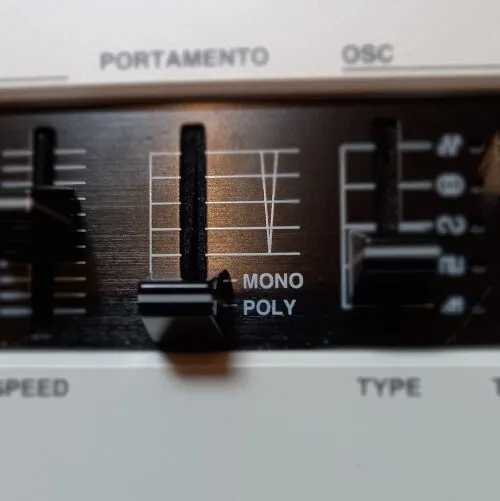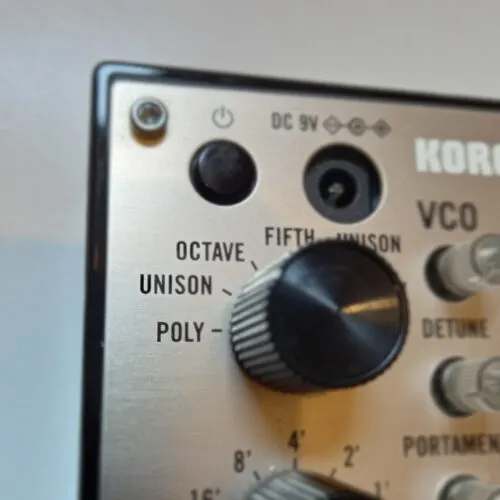If you’re just getting started with synthesizers, you may be wondering what’s the difference between mono and poly synths.
The difference between monophonic and polyphonic synthesizers is that a monophonic synthesizer only has 1 voice, whereas polyphonic synthesizers have multiple voices.
Seems simple, right? Well, there’s a bit more to it than that.
As an owner of both types, I’ve put together the below article to help you fully understand the difference between mono and poly synths, and whether a mono or poly synth is right for you.
It’s all about voices
When it comes to mono vs poly synths, the largest and most critical difference is the number of voices each one has.
A monophonic synthesizer only has 1 voice, which means that only 1 note can be played and processed by the synth at a time. This means that the first note played will immediately stop when a second note is played, and so on. This is called voice stealing.
Polyphonic synthesizers, however, have multiple voices which means that more than one note can be played at the same time.
For example, in an 8 voice polysynth, up to 8 notes can be played at the same time. This means that the first note played could continue to ring out even if a second note is played. If a 9th note was played, however, voice stealing would occur and the 1st note played would stop.

Each voice, in both a monophonic and polyphonic synth, will be made up of 1 or more oscillators. Oscillators are the waveforms that generate the sound within a synth. Generally speaking, the more oscillators that are present, the thicker the sound is.
Monosynths tend to sound thicker as every oscillator is used when a note is triggered, in most instances.
On the other hand, polysynths only tend to use 1 or 2 oscillators per voice. This is to avoid making the sound too “thick” when all the voices are playing together, but can mean that the sound is thinner when playing solo parts.
What this means is that monophonic synthesizers are generally used more for basslines and solo’s, whereas polyphonic synthesizers lend themselves better for pads, or “piano style” two-handed playing.
This is not always the case, though, as functions like paraphony and unison can change how both synths make sound, giving them both more versatility.
Paraphony and Unison
In some cases, monosynths can play chords and polysynths can be used as a monosynth.
This is by using paraphony for a mono synth and unison for a poly synth.
Paraphony
Having multiple voices in a synthesizer is expensive as more physical components are needed, and a more complex design is required.
In the earlier days of synthesizers, paraphony was created as a way to allow synths to play multiple notes at the same time, without the additional costs of adding these extra components.
This is achieved by utilising the different oscillators of a synth to play different pitches. For example, in a 3 oscillator synth, a 3 note chord could be played.
Some modern synths, such as the Korg Volca Keys or the Arturia MicroFreak still use paraphony to give extra usability to an otherwise monophonic synthesizer.
This does have it’s limitations, though, as the oscillators are still part of the same voice. This means that notes can’t be played one after the other and “ring-out”, as voice stealing will still occur if one note is pressed after the other. Paraphony is best suited for playing simple chords.
A similar effect to paraphony can also be achieved by some monosynths where the oscillators can be manually tuned. For example, in a 3 oscillator synth, tuning the 2nd and 3rd oscillators to a 3rd and 5th note respectively will play a major chord of the pressed note.
Unison
Like paraphony is the “kind-of polyphony” for a monophonic synth, unison is the “kind-of monophony” for a polyphonic synth.

Unison combines the different voices in a polyphonic synthesizer to play at the same time. What this means is that when 1 note is played, multiple voices are triggered which can lead to a thicker sound.
As each voice in a poly synth is processed independently, it’s not quite the same as a mono synth, but it will achieve essentially the same effect, and that’s a thicker sound that can be used for basslines or solo’s.
What do they cost?
For most beginners, a key consideration in the mono vs poly debate is the price.
Monophonic synthesizers are generally cheaper than their polyphonic counterparts. This is because they require less components to build, and are generally simpler in design.
For example, the Korg Monologue (Monophonic) and Korg Minilogue (Polyphonic) are mono and poly synths using the same technology. The Monologue retails for $354 whereas the Minilogue sells for $500.
You can pick up synths that have both mono and full poly modes, like the Yamaha Reface CS which is what I use. I recommend it if you’re getting started with synths and want a powerful unit that can do both.
You can pick one up on Amazon using the link below. I’ll get a commission from Amazon, at no additional cost to you!
Top tip: Like their hardware counterparts, software mono synths also require less processing than poly synths. This means that they will put less strain on your CPU.
Which type of synth is right for you?
Now that you know the difference between mono and poly synths, you might be wondering which one is right for you.
I’ve put the below together to help give you an idea of what to expect with each type of synth,
Uses for a poly synth
Because poly synths have multiple voices, they’re the most versatile type of synthesizer. This means that they’re best suited for:
- Chords
- Piano style playing
- Ambient pads
A poly synth can provide a lot of atmosphere and character to a song, from short punchy chords to drive the rhythm, to long and evolving pads that provide an ethereal mystery.
The strength of the poly synth is its ability to stack voices. As they tend to use only 1 or 2 oscillators per voice, they can sound too thin or weak for basslines, solos, or as a lead. As discussed, if the synth has a unison option, this can be used to thicken up the sound.
Uses for a mono synth
As mono synths only have 1 voice, they’re limited as to what role they can play in a song. A mono synth is usually best suited for:
- Basslines
- Solos
- Leads
As mono synths utilise multiple oscillators, it gives the sound a rich and thick quality that can cut through in a mix or performance.
If the mono synth has a paraphonic function, or the ability to tune oscillators independently, it means that you can still get some harmonic content in the form of chords without the price tag of a poly synth, albeit with some limitations.
You may be wondering why someone would buy a mono synth instead of a poly synth with unison. The answer, aside from the price difference, usually comes down to the fact that a mono synth plays differently than a poly synth.
Styles like portamento, trills, or legato playing techniques work differently on both instruments, and some people prefer a dedicated mono synth.
A similar comparison may be made between guitar versus a bass. While they look similar, they both have different play styles that lend them well to different roles.
Summary
You should now know the difference between mono and poly synthesizers, and have a better idea on whether a mono or poly synth is right for you.
To summarise:
- A mono synth has 1 voice, whereas a polysynth has multiple voices
- Mono synths are generally cheaper than poly synths
- Mono synths are generally used for basslines, solos, and leads
- Poly synths are generally used for chords, piano style playing, and pads
- Paraphony can give a mono synth some polyphonic capabilities
- Unison can give a poly synth some monophonic capabilities
Related Questions
Can you play chords on a monosynth?
A mono synth can play chords if it has paraphonic capability, or multiple oscillators that can be tuned independently. In the latter case, each oscillator would be tuned to a different interval, which would then form a chord.

Conor is a music producer, multi-instrumentalist, and all-round enthusiast from the UK with over 15 years of experience. He’s the founder and sole-content creator for the roundtable audio blog and YouTube channel.
